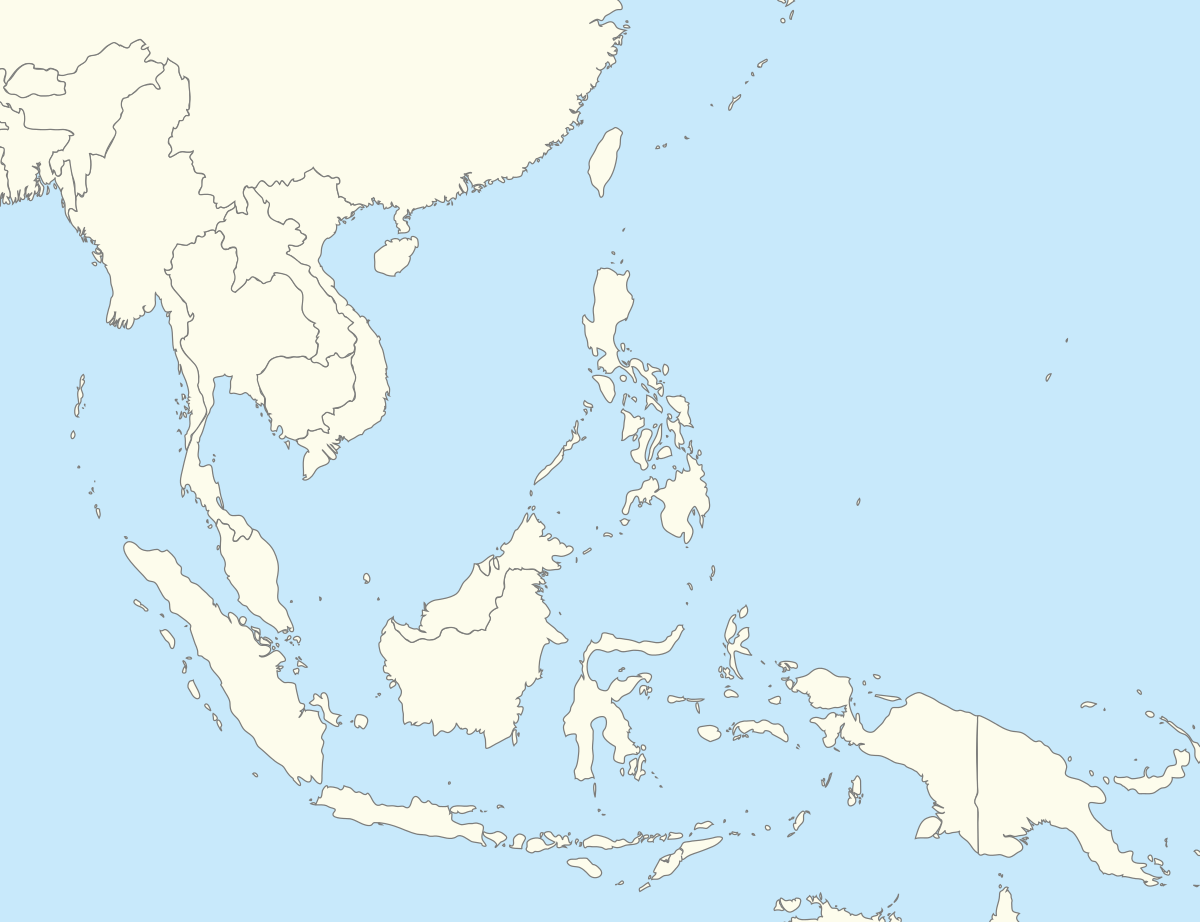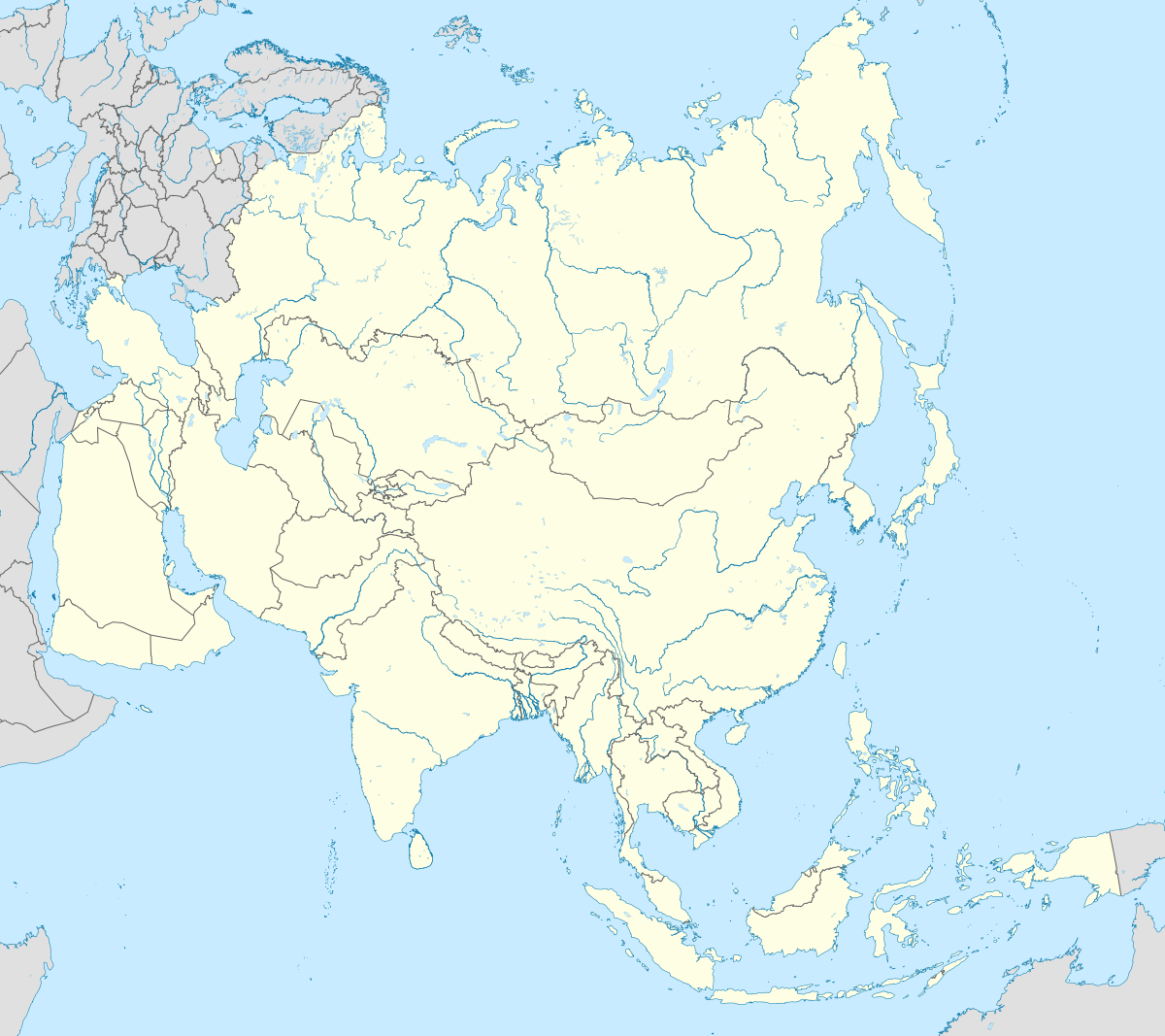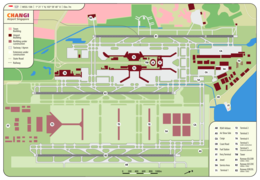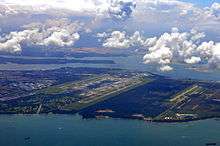Singapore Changi Airport
Singapore Changi Airport, commonly known as Changi Airport (IATA: SIN, ICAO: WSSS, FAA LID: SIN), is a major civilian airport that serves Singapore, and is one of the largest transportation hubs in Asia. It is currently rated the World's Best Airport by Skytrax for the eighth consecutive year since 2013.[10] It is the first Airport in the world to do so for eight consecutive years, and is one of the world's busiest airports by international passenger and cargo traffic.
Singapore Changi Airport Lapangan Terbang Changi Singapura 新加坡樟宜机场 சிங்கப்பூர் சாங்கி விமான நிலையம் | |||||||||||||||||||
|---|---|---|---|---|---|---|---|---|---|---|---|---|---|---|---|---|---|---|---|
 | |||||||||||||||||||
| Summary | |||||||||||||||||||
| Airport type | Public / Military | ||||||||||||||||||
| Owner | Government of Singapore[1] | ||||||||||||||||||
| Operator |
| ||||||||||||||||||
| Serves | Singapore | ||||||||||||||||||
| Location | Changi, East Region, Singapore | ||||||||||||||||||
| Opened | 1 July 1981 (operational) 29 December 1981 (official) | ||||||||||||||||||
| Hub for | |||||||||||||||||||
| Focus city for | |||||||||||||||||||
| Time zone | SST (UTC+08:00) | ||||||||||||||||||
| Elevation AMSL | 6.66 m / 22 ft | ||||||||||||||||||
| Coordinates | 01°21′33″N 103°59′22″E | ||||||||||||||||||
| Website | changiairport | ||||||||||||||||||
| Map | |||||||||||||||||||
.svg.png) SIN /WSSS Location in Singapore  SIN /WSSS SIN /WSSS (Southeast Asia)  SIN /WSSS SIN /WSSS (Asia) | |||||||||||||||||||
| Runways | |||||||||||||||||||
| |||||||||||||||||||
| Statistics (2019) | |||||||||||||||||||
| |||||||||||||||||||
The airport is located in Changi, at the eastern end of Singapore, approximately 20 km (12 mi)[11] from Marina Bay (Singapore's Downtown Core), on a 13-square-kilometre (5.0 sq mi) site. The airport is operated by Changi Airport Group and it is the home base of Singapore Airlines,[12] Singapore Airlines Cargo,[12] SilkAir,[12] Scoot, Jetstar Asia Airways and BOC Aviation.[12]
In 2019, Changi served 68.3 million passengers, making it the 18th busiest airport in the world.[13]
Overview

Changi Airport serves more than 100 airlines flying to 380 cities in around 100 countries and territories worldwide, as of 31 December 2019. About 7,400 flights arrive or depart at Changi each week – about one every 80 seconds.
For the 2019 full-year figures published by the airport, the airport handled 68,300,000 passengers (a 4.0% increase over the previous year), the most in its 38-year history.[8] This made it the seventh busiest airport by international passenger traffic in the world and the third busiest in Asia. In December 2019, Changi Airport registered a total of 6.41 million passenger movements, the highest the airport has ever achieved in a month since it opened in 1981. Its daily traffic movement record was also broken on 20 December 2019, with 226,692 passengers passing through during that day. In addition to being an important passenger hub, the airport is also one of the busiest cargo airports in the world, handling 2.01 million tonnes of cargo in 2019. The total number of commercial aircraft movements decreased by 1.0% from the previous year to 382,000 in 2019.[8]
The airport has won over 620 awards since its opening, including 28 "Best Airport" awards in 2019 alone.[14] Changi Airport's efforts to mitigate the effects of ageing infrastructure include continual physical upgrades to its existing terminals and building new facilities to maintain its high standards in airport service quality.[15]
Passenger terminals
Changi Airport has five main passenger terminals arranged in an elongated inverted 'U' shape with Jewel in the centre of the ‘U’ shape. Currently, the airport has a designed total annual handling capacity of 85 million passengers.[16]
- Terminal 1 began operations on 1 July 1981,[17] is located at the northern end, and was renovated in 2019.[18]
- Terminal 2 began operations on 22 November 1990,[19] and is located at the eastern end. (Operations have been suspended from 1 May 2020 for 18 months.)[20]
- Terminal 3 began operations on 9 January 2008,[21] officially opened on 25 July 2008,[22] and is located at the western end.
- Terminal 4 began operations on 31 October 2017[23] and is located on the southern side, at the site of the former budget terminal. (Operations have been suspended indefinitely from 16 May 2020 due to weak demand as a result of the COVID-19 pandemic in Singapore.)[24]
There is also a privately run luxury terminal called the JetQuay CIP Terminal. It is similar to the Lufthansa First Class Terminal at Frankfurt Airport, but is open to all passengers travelling in all classes on all airlines with an access fee.[25]
The short-lived Budget Terminal was opened on 26 March 2006 and closed on 25 September 2012 to make way for Terminal 4.[26]
Mixed-use development

Jewel Changi Airport, which opened on 17 April 2019, is a multi-use structure, mainly a shopping mall, interconnecting Terminals 1, 2 and 3.[27] Announced in 2013, it was a new terminal structure that is intended to be a mixed-use complex.[28] It is situated on a 3.5-hectare site where the Terminal 1 car park used to reside. Jewel was developed by Jewel Changi Airport Trustee Pte Ltd, a joint venture between Changi Airport Group and CapitaLand, through its wholly owned shopping mall business, CapitaLand Mall Asia.[29] The project cost S$1.7 billion.[30] Part of this project was planned to help expand Terminal 1 to handle 24 million passengers per year by 2018.[31]
Future terminals and projects
Terminal 5 is set to be ready in the mid 2030s. It is expected to handle 50 million passenger movements per annum.[32] The airport terminal structure is projected to be larger than terminals 1, 2 and 3 combined. It will be built on reclaimed land to the east of the present terminals. It will be funded through the newly increased levy.[33] KPF Singapore with Heatherwick Studio, Architects 61, and DP Architects will provide architectural services. Arup Singapore, Mott MacDonald Singapore and Surbana Jurong Consultants will provide engineering services. Transport Minister Khaw Boon Wan said on 16 June 2020 that the Changi Terminal 5 project could be delayed by at least 2 years as a result of the Coronavirus pandemic.[34]
Operations

Passenger operations
As the airport only handles international passenger traffic, all terminals in operation are equipped with immigration-processing facilities for international travel.
After recovering from a drop in passenger traffic as a result of the September 11 attacks in 2001 and the severe acute respiratory syndrome (SARS) epidemic in 2003, the airport saw rapid growth in traffic, which hit the 30-million mark for the first time in 2004. In March 2008, prior to the full effect of the financial crisis of 2007–2010 on the global economy, the airport was predicted to handle 50 million passengers by 2012[35] due to the opening of casinos in Singapore and the phased liberalisation of the Asean aviation sector. As predicted, the airport surpassed the 50-million mark in 2012.[15]
On 18 December 2017, the airport surpassed the 60-million mark for the first time.[36][37]
The airport saw a record 65.6 million passenger movements in 2018 - beating 2017's record of 60 million passengers with a 5.5 per cent increase.[38]
In 2019, Firefly, the sole turboprop operator in Changi Airport, moved to Seletar Airport to make way for their jet operations.[39][40][41]
In 2020, due to the ongoing COVID-19 pandemic, passenger traffic fell 32.8% due to the weakened demand for February. For the next few months, it is estimated that the numbers would drop further.[42] The pandemic also resulted in a 18-month closure of Terminal 2, starting from 1 May 2020, as the reduced passenger traffic deemed the terminal unnecessary. The previously planned expansion of Terminal 2 would therefore benefit from the closure, as a side effect, where it is believed that the 18-month closure would accelerate the expansion works by a year.[20] Airlines previously utilising Terminal 2 would be reallocated to the remaining terminals.
Cargo
The Air Cargo Division of the Changi Airport Group (CAG) manages the Changi Airfreight Centre[43] located in the north of the airport premises.[44] The airport handled 1.81 million tonnes of air cargo in 2012, making it the 7th busiest airfreight hub in the world and the fifth busiest in Asia.[45] Due to Singapore's large electronics sector, electrical components constitute a significant part of the total cargo traffic handled at the airport. Changi airport has initiated attempts to expand into the perishable air cargo market. In 2015, Changi Airport handled 1,853,087 tonnes of air freight. Air Cargo World awarded the 2013 Air Cargo Excellence Award to Changi Airport for handling more than 1,000,000 tonnes of cargo in Asia.[46]
The airport handled 2,006,300 tonnes of cargo in 2016, making it the 13th top cargo airport in the world and the sixth in the Asia Pacific region.[47]
In 2017, the airport handled 2,125,226 tonnes of cargo. The top five cargo markets for the airport were China, Australia, Hong Kong, United States and India.[48]
Key markets and destinations
In 2018, Indonesia was the largest market for the airport, followed by Malaysia, China, Thailand, Australia, India, Hong Kong, Japan, Philippines and Vietnam. Kuala Lumpur was the top destination for travellers in the airport, followed by Bangkok, Jakarta, Hong Kong, Manila, Denpasar/Bali, Tokyo, Ho Chi Minh City, Taipei and Sydney.[49]
Safety and security

The Changi Airport Group (CAG) manages the overall safety and security of the airport. The Airport Management Division of the CAG manages the customer aspects of the airport's security, while the Aviation Security Unit oversees the airport's compliance with aviation security (AVSEC) policies, and manages AVSEC-related projects.[44] The airport's emergency and fire-fighting services are handled by the Airport Emergency Service Division.[50] The Airport Emergency Services handles all instances of rescue and fire-fighting within the airport premises as well as in surrounding waters. It operates from two main fire stations (Station 1 by Runway 1 along West Perimeter Road and Station 2 by Runway 2), one sub-station (Domestic Fire Station), and one sea rescue base near the airport.[51]
The airport's security comes under the regulatory purview of the Airport Police Division of the Singapore Police Force (SPF). The day to day discharge of security functions at the airport is performed by auxiliary police forces including Aetos Security Management, Certis CISCO and SATS Security Services. Aetos and SATS Security Services are affiliated to the ground handling companies of Dnata and Singapore Changi Airport Terminal Services respectively.[52] On 29 April 2008, CAAS signed its then-biggest single security contract for all airport-related security services by engaging Certis CISCO to provide security services at Singapore Changi Airport, as well as Seletar Airport, Changi Airfreight Centre, and the Singapore Air Traffic Control Centre.[53] It involves the deployment of about 2,600 Certis Cisco personnel, including armed Auxiliary Police Officers and unarmed aviation security officers to perform tasks such as screening checked baggage, controlling access to restricted areas, and screening passengers before they board their aircraft.[54]
Since the 11 September 2001 attacks and the naming of the airport as a terrorist target by the Jemaah Islamiyah, the airport's security has been tightened. Singapore Armed Force and Singapore Police Force officers, armed with assault rifles or sub-machine guns, has been deployed to patrol the terminals at random intervals.[55] Officers from the Gurkha Contingent are also dispatched to patrol the transit areas of the terminal buildings. These measures come at a cost partly borne by travellers in the form of a "passenger security service charge", imposed since 2002.[56]
In 2005, an upgrade in screening technology and rising security concerns led to luggage-screening processes being conducted behind closed doors, as opposed to them being done before check-in within public view. The screening of carry-on luggage and travellers are mostly conducted at individual departure gates, while check-in luggage is screened in the backrooms and secured before loading. A perimeter intrusion detection system for Changi Airport's perimeter fence has also been put in place to further strengthen the security of the airfield, while a biometric access control system for staff movement has been put in place since 2006.[56]
Airlines and destinations
Passenger
Cargo
Operational statistics
| Operational statistics (1980-1989) | ||||||||||
|---|---|---|---|---|---|---|---|---|---|---|
| Year | Passenger movements |
Passenger % change over previous year |
Airfreight movements (tonnes) |
Airfreight % change over previous year |
Aircraft movements |
Aircraft % change over previous year |
Notes | |||
| 1980 | 7,294,549 | N/A | N/A | 75,971 | ||||||
| 1981 | 8,152,158 | N/A | N/A | 71,365 | ||||||
| 1982 | 8,611,812 | N/A | N/A | 68,159 | ||||||
| 1983 | 8,679,152 | N/A | N/A | 67,594 | ||||||
| 1984 | 9,465,651 | N/A | N/A | 70,674 | ||||||
| 1985 | 9,856,830 | N/A | N/A | 73,223 | ||||||
| 1986 | 10,067,719 | 352,806 | 73,022 | |||||||
| 1987 | 11,203,793 | 419,099 | 76,276 | |||||||
| 1988 | 12,595,286 | 512,509 | 82,930 | |||||||
| 1989 | 14,136,367 | 577,610 | 87,421 | |||||||
| Sources:[125][126][127] | ||||||||||
| Operational statistics (1990-1999) | ||||||||||
|---|---|---|---|---|---|---|---|---|---|---|
| Year | Passenger movements |
Passenger % change over previous year |
Airfreight movements (tonnes) |
Airfreight % change over previous year |
Aircraft movements |
Aircraft % change over previous year |
Notes | |||
| 1990 | 15,620,758 | 623,841 | 97,675 | |||||||
| 1991 | 16,285,039 | 643,209 | 108,728 | |||||||
| 1992 | 18,100,155 | 719,004 | 125,526 | |||||||
| 1993 | 19,987,214 | 838,416 | 136,762 | |||||||
| 1994 | 21,644,677 | 1,009,764 | 145,334 | |||||||
| 1995 | 23,196,240 | 1,105,773 | 156,334 | |||||||
| 1996 | 24,514,248 | 1,190,457 | 166,749 | |||||||
| 1997 | 25,174,344 | 1,336,254 | 172,672 | |||||||
| 1998 | 23,803,180 | 1,283,660 | 165,242 | 1997 Asian financial crisis | ||||||
| 1999 | 26,064,645 | 1,500,393 | 165,961 | |||||||
| Sources:[128][129][130] | ||||||||||
| Operational statistics (2000-2009) | ||||||||||
|---|---|---|---|---|---|---|---|---|---|---|
| Year | Passenger movements |
Passenger % change over previous year |
Airfreight movements (tonnes) |
Airfreight % change over previous year |
Aircraft movements |
Aircraft % change over previous year |
Notes | |||
| 2000 | 28,618,200 | 1,682,489 | 173,947 | |||||||
| 2001 | 28,093,759 | 1,507,062 | 179,359 | September 11 attacks | ||||||
| 2002 | 28,979,344 | 1,637,797 | 174,820 | |||||||
| 2003 | 24,664,137 | 1,611,407 | 154,346 | 2002–2004 SARS outbreak | ||||||
| 2004 | 30,353,565 | 1,775,092 | 184,932 | |||||||
| 2005 | 32,430,856 | 1,833,721 | 204,138 | |||||||
| 2006 | 35,033,083 | 1,931,881 | 214,000 | |||||||
| 2007 | 36,701,556 | 1,918,159 | 221,000 | |||||||
| 2008 | 37,694,824 | 1,883,894 | 232,000 | |||||||
| 2009 | 37,203,978 | 1,633,791 | 240,360 | Financial crisis of 2007–2008 | ||||||
| Sources:[131][132][133] | ||||||||||
| Operational statistics (2010-2019) | ||||||||||
|---|---|---|---|---|---|---|---|---|---|---|
| Year | Passenger movements |
Passenger % change over previous year |
Airfreight movements (tonnes) |
Airfreight % change over previous year |
Aircraft movements |
Aircraft % change over previous year |
Notes | |||
| 2010 | 42,038,777 | 1,813,809 | 263,593 | |||||||
| 2011 | 46,543,845 | 1,865,252 | 301,711 | |||||||
| 2012 | 51,181,804 | 1,806,225 | 324,722 | |||||||
| 2013 | 53,726,087 | 1,850,233 | 343,800 | |||||||
| 2014 | 54,093,070 | 1,843,799 | 341,386 | |||||||
| 2015 | 55,448,964 | 1,853,087 | 346,334 | |||||||
| 2016 | 58,698,039 | 1,969,434 | 360,490 | |||||||
| 2017 | 62,219,573 | 2,125,226 | 373,201 | |||||||
| 2018 | 65,600,000 | 2,150,000 | 386,000 | |||||||
| 2019 | 68,300,000 | 2,010,000 | 382,000 | |||||||
| Sources:[134][135][136][137][138][139][140][141][142][143] | ||||||||||


Accidents and incidents
- On 26 March 1991, Singapore Airlines Flight 117, operated by an Airbus A310, was hijacked by four Pakistani terrorists. The flight landed in Changi Airport at 22:15. The Singapore Special Operations Force stormed the plane, on the morning of 27 March. All four hijackers were killed, with no fatalities among the 123 passengers and crew that were held hostage for more than eight hours.
- On 4 November 2010, Qantas Flight 32, operated by an Airbus A380-800, suffered an uncontained engine failure and made an emergency landing in Changi Airport. Upon landing, one of the engines could not be shut down due to ruptured control cables and had to be doused for three hours by airport firefighters to forcefully shut it down. There were no crew or passenger injuries, and all 469 people on board survived this incident.
- On 27 June 2016, Singapore Airlines Flight 368, operated by a Boeing 777-300ER, suffered an engine problem while flying from Singapore to Milan. During the diversionary landing in Singapore, the right engine and wing caught fire. The fire was quickly extinguished by airport fire services. There were no injuries among the 241 people on board.
- On 16 May 2017, a fire broke out at the departure hall in Terminal 2.[144] The fire caused 40 flights at Terminal 2 to be delayed and diverted to Terminal 3.[145] Terminal 2 was closed from 17:30 to 22:45.
- On 6 February 2018, a KAI T-50 Golden Eagle, part of the Black Eagles aerobatic team taking part in Singapore Airshow 2018, veered off the runway during takeoff and crashed. The resulting fire was put out by emergency services and the pilot was treated for minor injuries. Runway 1 was closed as a result and caused delays at the airport.[146]
- On 19 June 2019, unauthorised drones were spotted around Changi Airport, causing 37 flights to be delayed and a runway to be shut intermittently.[147] Another such incident took place on 24 June 2019, causing 18 flights to be delayed and 7 more diverted. The disruption was made worse by bad weather.[148]
Ground transportation
Changi Airport was built with ground-transportation considerations in mind from the onset, with the East Coast Parkway built and opened in tandem with the airport, providing a direct link to the city centre. At a distance of about 20 km (12 mi), the expressway was built almost entirely on reclaimed land, thus minimising disruptions to the existing road network in Singapore's East Coast.
Despite the four main passenger terminal buildings being relatively close to each other, the CAAS (Civil Aviation Authority of Singapore) decided to build the Changi Airport Skytrain people-mover system to facilitate quicker and more convenient transfers between the terminals for travellers. The system was upgraded in 2007 with new technologies supplied by Mitsubishi, connecting to Terminal 3 and separating checked-in passengers from the general public on distinct tracks.
Inter-terminal transportation
_-_Platform_A.jpg)
Terminals 1, 2 and 3 are connected by the free Skytrain service, which operates from 05:00 to 02:30. During non-operational hours, travellers in the transit areas may transfer within the terminals by foot via the inter-terminal travellators. For travellers in the public areas, a free shuttle bus service will connect the three terminals.[149]
All Skytrain services have been suspended from 1 May 2020 until further notice.
A complimentary 24-hour Airport Shuttle Bus service plies between Terminal 3 and Terminal 4 in both the public and transit areas. The journey takes approximately eight to 10 minutes.[150]
External connections
Mass Rapid Transit
The airport is connected to the Mass Rapid Transit (MRT) network via a two-stop branch of the East West line from Tanah Merah MRT station, consisting of two stations: Expo, serving the nearby Singapore Expo site; and Changi Airport. Changi Airport MRT station is located underground between Terminal 2 and Terminal 3. Direct, one-train service to the downtown and western parts of Singapore was initially in operation when the station opened on 8 February 2002. This was replaced by the current shuttle service between Tanah Merah and Changi Airport via Expo on 22 July 2003,[151] when it was found that passenger demand for this route was low.
Until Stage 3 of the Downtown line opened on 21 October 2017, passengers needed to transfer at Tanah Merah station for train service towards the city, Pasir Ris and Tuas Link. However, as of this date, passengers can now transfer at Expo for direct service to Bukit Timah and Bukit Panjang using an alternate route via the city.
As announced in the LTA's Land Transport Masterplan 2040, the new Thomson–East Coast line will be extended to Changi Airport Terminal 5 and to the current Changi Airport station, with the current EWL Branch line being converted to be part of the TEL.[152]
Bus
There are seven bus services operated by SBS Transit, SMRT Buses and Go-Ahead Singapore, making a loop starting from Terminal 3 to Terminal 1, and Terminal 2. Only four bus services will continue to Terminal 4 – Services 24, 34, 36 and 110. Bus stops are located at the basement bus bays of Terminals 1, 2 and 3. For Terminal 4, the bus stop is located next to Car Park 4B.
Coaches to and from Johor Bahru are also available. Operated by Transtar Travel, the service will start at coach stands at Terminals 1, 2, and 3, and end at Larkin Terminal.
There is also a free shuttle bus service plying between Changi Airport (T3) and Changi Business Park. This service is a nine-stop route, running from Mondays to Fridays, except public holidays.[153]
Taxi
Taxis are available at taxi stands located in the arrival halls of each terminal. Limousine services are also available. There is an additional airport surcharge for all trips originating from the airport.[154]
Private transport
All pick-ups by private transportation occur at the arrival pick-up points of each terminal.[155][156][157][158]
See also
References
Notes
- Runway 02L is 4,000 m (13,000 ft) and 20R is 3,260 m (10,700 ft) with a displaced threshold of 740 m (2,430 ft). Thus aircraft landing on 20R will have to avoid touching down on the displaced threshold but may use it for departures.
- To facilitate works for Terminal 5, Runway 02C/20C will be closed temporarily starting from October 2020.[4]
- Runway 02R/20L is solely for use by the Republic of Singapore Air Force (see Changi Air Base).[5] It will be available for commercial use on 25 October 2020.[6]
Citations
- "Who We Are". Changi Airport Group. Archived from the original on 2 December 2011.
- "FedEx opens flagship Asia hub". Singapore's Changi Airport. Aircargonews.net. Archived from the original on 1 August 2015. Retrieved 5 October 2012.
- "SIA-ANA pact will pave way for more flights, Japan destinations for Singapore consumers". Singapore Airlines, All Nippon Airways. The Straits Times. Retrieved 31 January 2020.
- "Singapore Changi Airport – Updated Information and Data for Runway 02R/20L". CNA. CNA. 4 November 2019. Retrieved 8 February 2020.
- "Singapore Changi Airport – Updated Information and Data for Runway 02R/20L" (PDF). AIP Singapore. Civil Aviation Authority of Singapore. 22 June 2018. Archived (PDF) from the original on 24 August 2018. Retrieved 23 August 2018.
- "Singapore Changi Airport – Updated Information and Data for Runway 02R/20L". CNA. CNA. 4 November 2019. Retrieved 8 February 2020.
- "The importance of air transport to Singapore". International Air Transport Association. Retrieved 12 May 2020.
- "Passenger, airfreight and aircraft movement statistics for 2019". Changi Airport Group. 31 January 2020. Retrieved 8 February 2020.
- "SINGAPORE CHANGI INTL". World Aero Data. WorldAeroData.com. Retrieved 2 March 2020.
- "World's Top 10 Airports 2020". Skytrax. Retrieved 11 May 2020.
- "Regulations" (PDF). Caas.gov.sg. Archived (PDF) from the original on 23 September 2015. Retrieved 3 March 2017.
- "singapore airlines | boeing | malaysia airlines | 2004 | 09 - 0311 | Flight Archive". web.archive.org. 22 March 2014. Retrieved 31 May 2020.
- "ACI reveals top 20 airports for passenger traffic, cargo, and aircraft movements". ACI World. 19 May 2020. Retrieved 31 May 2020.
- "OUR PRIDE". Changi Airport Group. 8 February 2020. Retrieved 8 February 2020.
- In 2019 the airport has installed one of the first drone detection systems "AARTOS". "A record 51 million passengers for Changi Airport in 2012" (PDF). Changaiairportgroup.com. Archived from the original (PDF) on 4 November 2013. Retrieved 3 March 2017.
- "The big picture: 40 years of Singapore Changi". Business Traveller. Retrieved 31 May 2020.
- "Changi Airport Infopedia". eresources.nlb.gov.sg. Retrieved 31 May 2020.
- Kaur, Karamjit (11 November 2018). "Changi Airport's $323 million T1 upgrade 85% complete". The Straits Times. Retrieved 20 June 2019.
- "First 137 passengers take off from Terminal 2". eresources.nlb.gov.sg. Retrieved 31 May 2020.
- "Parliament: Changi Airport T2 operations to be suspended for 18 months amid coronavirus outbreak". The Straits Times. 6 April 2020.
- "T3 TAKES OFF". eresources.nlb.gov.sg. Retrieved 31 May 2020.
- migration (25 July 2014). "Flashback Friday: Changi Airport Terminal 3 officially opened on July 25, 2008". The Straits Times. Retrieved 31 May 2020.
- "Terminal 4 Breaks New Ground for Changi | Changi Airport Group". www.changiairport.com. Retrieved 31 May 2020.
- "Changi Airport Terminal 4 to suspend operations amid COVID-19 pandemic". CNA. Retrieved 12 May 2020.
- "JetQuay". www.jetquay.com.sg. Retrieved 31 May 2020.
- "Changi Airport to open Terminal 4 on Oct 31; 9 airlines to operate from new terminal". The Straits Times. 6 September 2017. Archived from the original on 8 October 2017. Retrieved 25 September 2017.
- "Jewel Changi Airport to open on April 17". The Straits Times. 6 March 2019. Archived from the original on 7 March 2019. Retrieved 31 May 2020.
- "Changi Airport Group to develop iconic mixed-use complex". Changi Airport Group. 19 August 2013. Retrieved 31 May 2020.
- migration (20 December 2013). "Project Jewel at Changi Airport to cost $1.47b". The Straits Times. Archived from the original on 17 January 2018. Retrieved 31 May 2020.
- Karamjit Kaur (5 December 2014). "Work on Changi Airport's Jewel project and T1 expansion begins". The Straits Times. Archived from the original on 17 January 2018. Retrieved 9 January 2018.
- "Wayback Machine" (PDF). web.archive.org. 7 December 2014. Retrieved 31 May 2020.
- "Changi Airport's Terminal 5 ready in mid-2020s". Yahoo News Singapore. 30 August 2013. Archived from the original on 14 July 2015. Retrieved 10 May 2015.
- "Changi Airport passengers to pay new levy to fund developments including T5". Channel NewsAsia. 28 February 2018. Archived from the original on 29 July 2018. Retrieved 29 July 2018.
- hermesauto (16 June 2020). "Coronavirus: Changi Airport T5 construction to be 'paused' for at least 2 years, says Khaw". The Straits Times. Retrieved 16 June 2020.
- "Changi poised to handle 50 million passengers a year by 2012". Channel NewsAsia. 28 March 2008. Archived from the original on 28 December 2011. Retrieved 8 November 2011.
- "Flying higher, Changi Airport crosses 60-million milestone in 2017". changiairport.com. Archived from the original on 27 January 2016. Retrieved 27 January 2016.
- "Changi Airport hits record 60 million passengers in 2017". Channel NewsAsia. Archived from the original on 21 December 2017. Retrieved 18 December 2017.
- "Changi Airport hits record 65 million passengers in 2018". Channel NewsAsia. Archived from the original on 3 February 2019. Retrieved 2 February 2019.
- "Seletar Airport Prepares for Turboprop Service". Aviation Week & Space Technology. Archived from the original on 5 February 2018. Retrieved 5 February 2018.
- "Singapore 2018: Seletar Airport set for turboprop move". Air & Cosmos – International. Archived from the original on 17 February 2018. Retrieved 6 February 2018.
- "Malaysian carrier Firefly resumes flights to Singapore as first plane lands at Seletar Airport". CNA. Retrieved 17 June 2019.
- Mui, Rachel (13 March 2020). "Changi Airport February passenger traffic falls 32.8% as virus hits travel demand". The Business Times.
- "Changi Airfreight Centre". Changi Airport Group. Archived from the original on 30 September 2015.
- "Our Divisions". Civil Aviation Authority of Singapore (CAAS). Archived from the original on 26 September 2006. Retrieved 3 November 2006.
- "Year to date International Freight Traffic". Airports Council International. 19 March 2012. Archived from the original on 6 April 2012.
- "2013 Awards". Air Cargo World. 2013. Archived from the original on 28 August 2013. Retrieved 9 August 2013.
- "Air Cargo. Still the Cinderella of the airline business – CAPA's top 20 cargo airports". CAPA – Centre for Aviation. Archived from the original on 22 December 2017. Retrieved 22 December 2017.
- "A record 62.2 million passengers for Changi Airport in 2017". www.changiairport.com. Archived from the original on 27 January 2016. Retrieved 23 January 2018.
- "Annex B - Top 10 routes from Singapore for 2018". changiairport.com. Archived from the original on 27 January 2016. Retrieved 29 January 2019.
- Changi Airport Group Annual Report 2009/10 Archived 28 October 2010 at the Wayback Machine. (PDF) Retrieved 15 August 2012.
- "Civil Fire Stations". Changi Airport Group. Archived from the original on 18 May 2011. Retrieved 12 June 2011.
- "Changi Airport's third ground handling licence awarded to ASIG". Channel NewsAsia. 9 June 2011. Archived from the original on 10 August 2011. Retrieved 8 November 2011.
- "Certis CISCO awarded $360 million Master Security Services Contract by CAAS". Certissecurity.com. 28 April 2008. Archived from the original on 2 October 2011. Retrieved 8 November 2011.
- 50 Years of Securing Your World Archived 8 July 2011 at the Wayback Machine . Annual Review 2008/2009. certissecurity.com (PDF). Retrieved 15 August 2012.
- "Counter Terrorism Efforts at Singapore's Changi Airport". South Asia Analysis Group. Archived from the original on 12 June 2010. Retrieved 12 June 2011.
- "Changi Airport to Impose Security Levy (Page 5)". The Straits Times (retrieved from NLB). 10 January 2002. Retrieved 3 September 2019.
- https://www.routesonline.com/news/38/airlineroute/291532/aeroflot-revises-planned-long-haul-additions-in-202021/
- Liu, Jim. "Air China resumes Hangzhou – Singapore service from late-July 2020". Routesonline. Retrieved 5 August 2020.
- "Air India Express adds Bangalore – Singapore from late-Oct 2018". Routesonline. 28 September 2018. Archived from the original on 2 October 2018. Retrieved 2 October 2018.
- "Air New Zealand to operate Singapore-Christchurch service from December 2019". The Straits Times. 10 December 2018. Archived from the original on 12 February 2019. Retrieved 11 February 2019.
- "Drukair Royal Bhutan Airlines launches inaugural cross-equator flight to Dili on 31 October 2019". AirSoc. Retrieved 31 October 2019.
- "AirAsia to commence Ipoh-Singapore service in Dec-2018". centreforaviation.com. Archived from the original on 27 October 2018. Retrieved 23 October 2018.
- "AirAsia X schedules Singapore launch in Nov 2019". Routesonline.
- "AirAsia X to operate 2 daily Kuala Lumpur – Singapore service from 10NOV19". 30 October 2019.
- "China Eastern expands South East Asia Network in S19". routesonline. Retrieved 12 March 2019.
- "China Southern Airlines SG". www.facebook.com. Retrieved 21 August 2019.
- "Drukair Royal Bhutan Airlines". www.facebook.com.
- "Ethiopian Airlines NS20 South East Asia routing changes". Routes Online.
- "Go Air adds Singapore service from late-Oct 2019". Routesonline.
- "Hainan Airlines plans to resume Haikou – Singapore from late-Nov 2018". routesonline. Archived from the original on 17 October 2018. Retrieved 17 October 2018.
- "Hebei Airlines resumes scheduled flight from Hangzhou to Singapore on 18 January 2020". Airsoc.
- "New Flights Information, Status & Schedule | IndiGo". www.goindigo.in.
- "AirAsia to move its operations in Yogyakarta to Yogyakarta International Airport, Kulon Progo starting 29 March 2020". AirAsia. Retrieved 19 March 2020.
- https://www.channelnewsasia.com/news/singapore/covid19-jetstar-asia-resumes-flights-manila-bangkok-kuala-lumpur-12658394
- "Jetstar Asia Will Soon Have Direct Flights Between Singapore and Clark, Pampanga". tripzilla.com. Archived from the original on 16 August 2017. Retrieved 25 September 2017.
- https://www.routesonline.com/news/38/airlineroute/291929/jetstar-asia-moves-colombo-august-launch-to-late-oct-2020/
- "Jeju Air stretches longer haul, opening Busan-Singapore route July 4 - Pulse by Maeil Business News Korea". pulsenews.co.kr. Retrieved 21 August 2019.
- Toh, Mavis (30 November 2018). "PICTURES: Juneyao plans international boost with 787s". Flightglobal. Archived from the original on 1 December 2018. Retrieved 30 November 2018.
- "KLM July/August 2020 Inter-continental operations as of 26JUN20". Retrieved 29 June 2020.
- "Direct connection to Singapore". lot.com. Archived from the original on 17 November 2017. Retrieved 16 November 2017.
- 2017, UBM (UK) Ltd. "LOT Polish Airlines resumes Singapore service from May 2018". Routesonline. Archived from the original on 17 November 2017. Retrieved 17 November 2017.CS1 maint: numeric names: authors list (link)
- "Qantas ditches Dubai, returns A380 to Sydney-Singapore-London". Australian Business Traveller. Archived from the original on 31 August 2017. Retrieved 31 August 2017.
- "Scoot Starts Sale Of Singapore-Laos Flights" (PDF). cdn.flyscoot.com. Archived (PDF) from the original on 13 January 2019. Retrieved 10 January 2019.
- 2018, UBM (UK) Ltd. "Scoot / Silk Air 2019 network adjustment as of 30NOV18". Routesonline. Archived from the original on 5 December 2018. Retrieved 5 December 2018.CS1 maint: numeric names: authors list (link)
- "Frequent fliers on some SilkAir routes will soon have to fly Scoot, SIA announces ahead of merger". businessinsider.sg. Retrieved 30 October 2019.
- "Scoot launches non-stop flights to Changsha and Kunming in June 2019". AirSoc. 29 April 2019. Retrieved 29 April 2019.
- "Scoot launches flight to Fuzhou on 5 July 2019". AirSoc. 29 April 2019. Retrieved 29 April 2019.
- "Scoot to commence Kota Bharu service in Jul-2019". centreforaviation.com. Archived from the original on 15 February 2019. Retrieved 15 February 2019.
- "Scoot launches non-stop flights to Changsha and Kunming in June 20119". AirSoc. Retrieved 29 April 2019.
- Liu, Jim (9 April 2020). "Scoot plans Manado launch from June 2020". Routesonline.
- "Scoot adds Vishakhapatnam service in W19". Routesonline. Archived from the original on 14 December 2018. Retrieved 14 December 2018.
- "Scoot assumes Silk Air Wuhan service from late-May 2019". Airlineroute. 1 May 2019. Retrieved 1 May 2019.
- Liu, Jim. "Scoot files expanded Indonesia network July - Oct 2020 as of 12JUN20". Routesonline. Retrieved 16 June 2020.
- "SIA to take over SilkAir's flights to Busan and raise seat capacity". The Straits Times. 12 September 2019.
- Mui, Rachel (8 January 2020). "Singapore Airlines adding fifth weekly flight to Kolkata". The Business Times.
- Liu, Jim. "United extends International / Guam / Micronesia Island Hopper interim schedule to Sep 2020". Airlineroute. Retrieved 5 July 2020.
- "Urumqi Air launches Urumqi - Wuhan - Singapore flights on 18 May 2019". AirSoc. Retrieved 6 April 2019.
- "Vietjet Air begins scheduled flight between Singapore and Danaang on 20 December 2019". AirSoc. Retrieved 8 November 2019.
- https://www.vietjetair.com/Sites/Web/en-us/NewsDetail/news/2644/vietjet-opens-new-route-from-hanoi-to-singapore
- https://www.vietjetair.com/Sites/Web/en-us/NewsDetail/news/1277/enjoy-free-flights-to-ho-chi-minh-city-on-vietjet-and-wow-gifts-every-day
- "Vistara begins international service with Singapore launch in Aug 2019". Routesonline. Retrieved 21 August 2019.
- "AirBridgeCargo Airlines debuts at Singapore Changi Airport with direct freighter flights from Moscow". Archived from the original on 27 January 2016. Retrieved 27 January 2016.
- "AirBridgeCargo is on its way developing services in Asia | Company news | Media Centre | AirBridgeCargo". airbridgecargo.com. Archived from the original on 12 July 2016.
- "Air HongKong". Archived from the original on 9 December 2014. Retrieved 10 May 2015.
- "ANA Cargo International Timetable & Connections" (PDF). ANA Cargo. Archived (PDF) from the original on 9 February 2019. Retrieved 9 February 2019.
- "Schedules by Route". www.asianacargo.com. Archived from the original on 9 February 2019. Retrieved 9 February 2019.
- "Cardig Air Scheduled Timetable". Cardigair.com. Archived from the original on 4 November 2013. Retrieved 1 January 2014.
- "Air Antilles flight 3S531". Flightradar24. Archived from the original on 31 January 2019. Retrieved 31 January 2019.
- "2013 summer schedule". Aero Logic. Archived from the original on 8 August 2013. Retrieved 13 August 2013.
- "Polar Air Cargo Worldwide launches new freighter service to Singapore" (PDF). Changaiairportgroup.com. Archived from the original (PDF) on 4 March 2016. Retrieved 3 March 2017.
- "Emirates SkyCargo Freighter Operations get ready for DWC move". Emirates SkyCargo. 2 April 2014. Archived from the original on 25 February 2015. Retrieved 25 February 2015.
- "Etihad Cargo Flight Schedule" (PDF). Archived from the original (PDF) on 26 April 2014.
- "Etihad Cargo operates Boeing 777F to Singapore" (PDF). Archived from the original (PDF) on 19 October 2013.
- "EVA Air flight BR6052". Flightradar24. Archived from the original on 26 January 2018. Retrieved 26 January 2018.
- "EVA Air Cargo Flight Schedule" (PDF). evaair.com. Archived (PDF) from the original on 18 August 2018. Retrieved 26 January 2018.
- "FedEx Express Launches Sydney-Singapore Flight To Support Australian Business Growth". FedEx. Archived from the original on 6 November 2018. Retrieved 30 October 2018.
- "Hong Kong Airlines Cargo". Archived from the original on 7 July 2015. Retrieved 10 May 2015.
- "Warszawa - Singapur - nowy kierunek LOT Cargo". pasazer.com. 24 June 2020. Retrieved 25 June 2020.
- "New Route From Surabaya to Singapore". My Indo Airlines. Archived from the original on 1 February 2016. Retrieved 29 January 2015.
- "Neptune Air". neptuneair.com. Archived from the original on 9 June 2017. Retrieved 8 March 2017.
- "Silk Way West Airlines flight 7L633". Flightradar24. Archived from the original on 24 September 2017. Retrieved 28 September 2017.
- "Silk Way West Airlines flight 7L634". Flightradar24. Archived from the original on 24 September 2017. Retrieved 28 September 2017.
- "Silk Way West Airlines flight 7L671". Flightradar24. Archived from the original on 26 January 2018. Retrieved 26 January 2018.
- "Singapore Airlines Cargo to commence Singapore-Hanoi freighter service in Nov-2014". CAPA. 14 November 2014. Archived from the original on 29 November 2014. Retrieved 14 November 2014.
- "1980-1989 Singapore Changi Airport Passenger Movements". Department of Statistics, Singapore. Retrieved 20 June 2020.
- "1986-1989 Singapore Changi Airport Airfreight movements 1". Department of Statistics, Singapore. Retrieved 20 June 2020.
- "1986-1989 Singapore Changi Airport Airfreight movements 2". Department of Statistics, Singapore. Retrieved 20 June 2020.
- "1990-1999 Singapore Changi Airport Passenger Movements". Department of Statistics, Singapore. Retrieved 20 June 2020.
- "1986-1989 Singapore Changi Airport Airfreight movements 1". Department of Statistics, Singapore. Retrieved 20 June 2020.
- "1986-1989 Singapore Changi Airport Airfreight movements 2". Department of Statistics, Singapore. Retrieved 20 June 2020.
- "2000-2009 Singapore Changi Airport Passenger Movements". Department of Statistics, Singapore. Retrieved 20 June 2020.
- "2000-2009 Singapore Changi Airport Airfreight movements 1". Department of Statistics, Singapore. Retrieved 20 June 2020.
- "2000-2009 Singapore Changi Airport Airfreight movements 2". Department of Statistics, Singapore. Retrieved 20 June 2020.
- "2010 Singapore Changi Airport Statistics" (PDF). Changi Airport Group. 20 January 2011. Retrieved 20 June 2020.
- "2011 Singapore Changi Airport Statistics" (PDF). Changi Airport Group. 20 January 2012. Archived from the original (PDF) on 17 April 2016. Retrieved 30 March 2016.
- "2012 Singapore Changi Airport Statistics" (PDF). Changi Airport Group. 31 January 2013. Archived from the original (PDF) on 17 April 2016. Retrieved 30 March 2016.
- "2013 Singapore Changi Airport Statistics" (PDF). Changi Airport Group. 28 January 2014. Archived from the original (PDF) on 1 July 2014. Retrieved 30 March 2016.
- "2014 Singapore Changi Airport Statistics" (PDF). Changi Airport Group. 29 January 2015. Archived from the original (PDF) on 30 September 2015. Retrieved 30 March 2016.
- "2015 Singapore Changi Airport Statistics". Changi Airport Group. 27 January 2016. Archived from the original on 27 January 2016. Retrieved 30 March 2016.
- "2016 Singapore Changi Airport Statistics". Changi Airport Group. 30 January 2017. Archived from the original on 27 January 2016. Retrieved 30 January 2017.
- "2017 Singapore Changi Airport Statistics". Changi Airport Group. 23 January 2018. Archived from the original on 27 January 2016. Retrieved 23 January 2018.
- "Changi Airport crosses 65 million passenger mark in 2018". changiairport.com. Archived from the original on 27 January 2016. Retrieved 10 February 2019.
- "Passenger, airfreight and aircraft movement statistics for 2019". Changi Airport Group. 31 January 2020. Retrieved 8 February 2020.
- "'Small fire' at Changi Airport T2 sparks evacuation, flight delays". Channel NewsAsia. Archived from the original on 19 May 2017. Retrieved 16 May 2017.
- "Changi Airport fire: About 40 flights affected by Terminal 2 closure". Channel NewsAsia. Archived from the original on 19 May 2017. Retrieved 17 May 2017.
- Chin, Nigel (6 February 2018). "Korean plane taking part in Singapore Airshow crashes, catches fire at Changi Airport; flight delays expected". Channel NewsAsia. Retrieved 6 February 2018.
- Abdullah, Zhaki (19 June 2019). "Unauthorised drones around Changi Airport delay 37 flights, affect operations of one runway". The Straits Times. Retrieved 22 June 2019.
- Wong, Lester (24 June 2019). "Drones, bad weather cause flight delays and diversions at Changi Airport on Monday". The Straits Times. Retrieved 26 June 2019.
- "Transfer Between Terminals". changiairport.com. Skytrain. Archived from the original on 4 May 2018. Retrieved 3 May 2018.
- "Transfer Between Terminals – Terminal 4 Shuttle Bus". www.changiairport.com. Archived from the original on 19 March 2018. Retrieved 3 May 2018.
- "Singapore MRT (Metro)". UrbanRail.Net. Archived from the original on 1 May 2007. Retrieved 18 April 2007.
- "Land Transport Master Plan 2040" (PDF).
- "Shuttle Services". changiairport.com. Archived from the original on 10 September 2017. Retrieved 28 September 2017.
- "Taxi Surcharges".
- "Private Transport Pick-up". changiairport.com. Archived from the original on 20 February 2018. Retrieved 19 February 2018.
- "Your Changi Airport Guide". Grab SG. Archived from the original on 20 February 2018. Retrieved 18 November 2016.
- "Request Uber at Singapore Changi International Airport (SIN)". uber.com. Archived from the original on 20 February 2018. Retrieved 19 February 2018.
- "Instructions For Drivers at Changi Airport". uber.com. Archived from the original on 20 February 2018. Retrieved 19 February 2018.
Bibliography
- Winchester, Clarence, ed. (1938), "Singapore's great airport", Wonders of World Aviation, pp. 128–130, illustrated description of the newly opened Singapore Airport
External links
| Wikivoyage has a travel guide for Singapore Changi Airport. |
| Library resources about Singapore Changi Airport |
![]()